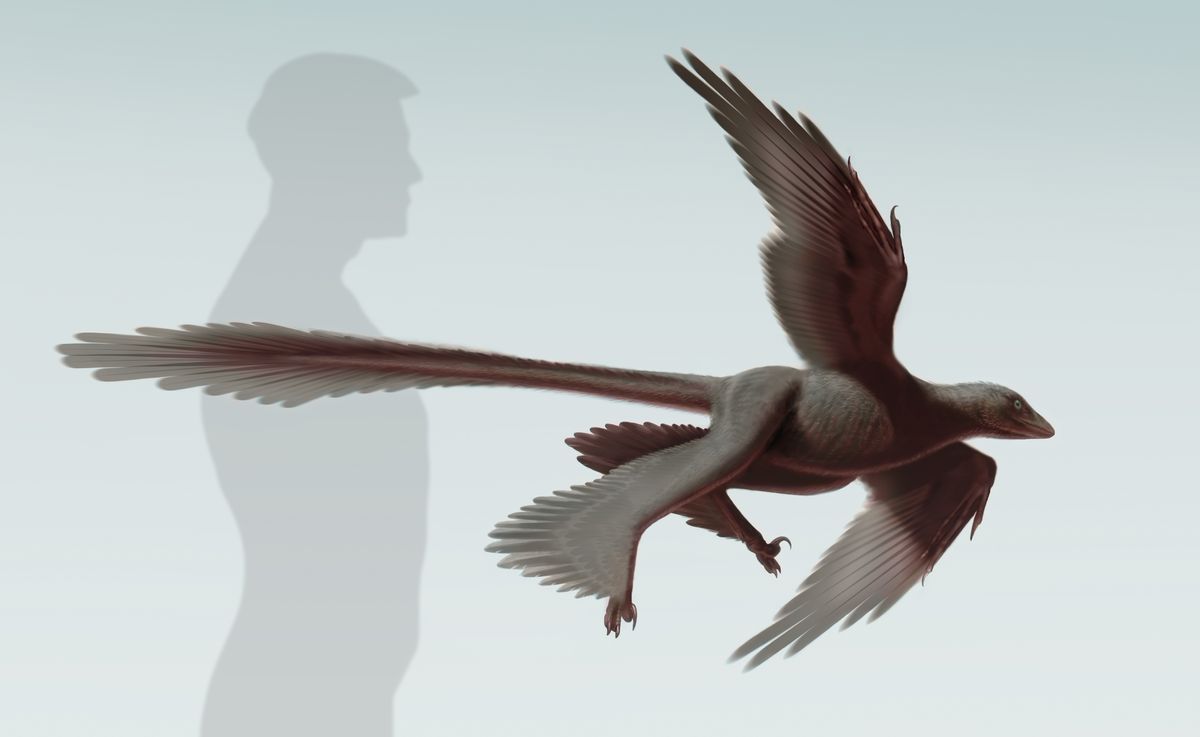Bizarre Dinosaur Had 4 'Wings,' Long Tail Feathers

The largest "four-winged" dinosaur known has been found, and this predator has the longest feathers yet outside of birds, researchers say. This new finding yields insights on how dinosaurs may have flown, the scientists added.
The 125-million-year-old feathered dinosaur, named Changyuraptor yangi, sported feathers over its body, including its arms and legs, which made it look as if it had two pairs of wings. Its fossil was unearthed in 2012 in Liaoning province in northeastern China, which has been the center of a surge of discoveries of feathered dinosaurs over the last decade.
"The vast majority of feathered dinosaurs in Liaoning are collected by farmers who live there," said study author Luis Chiappe, a paleontologist and director of the Dinosaur Institute at the Natural History Museum of Los Angeles County.
The newfound dinosaur is a microraptorine, a group of predatory, feathered dinosaurs related to Velociraptor and other well-known raptor dinosaurs. Analysis of the microscopic structure of this fossil's bones reveal it was a fully grown adult — a younger specimen's bones would have signs they were still developing.
"Microraptorines are thought to be very close cousins of birds, sharing a common raptor ancestor," Chiappe told Live Science. "It's not known yet whether a four-wing body is something unique to microraptorines, or something the common ancestor of birds and microraptorines had, that was later lost in the bird lineage." [Image Gallery: Dinosaur Fossils]
The researchers estimate 4-foot-long (1.2 meter) Changyuraptor weighed about 9 lbs. (4 kilograms), making it the largest four-winged dinosaur found yet, and at least 60 percent larger than the largest microraptorine specimen found previously, Chiappe said.
When Changyuraptor was alive, the area in which it lived "was a broad peninsula or wedge into the ocean, with volcanoes," Chiappe said. "It was a moist temperate forest, mostly of conifer trees and gingkos, with dry hot summers and pretty cold winters. There were a variety of meat-eating and plant-eating dinosaurs in the area, including Yutyrannus, a feathered relative of Tyrannosaurus maybe 27 to 30 feet (8.2 to 9.1 m) long."
Sign up for the Live Science daily newsletter now
Get the world’s most fascinating discoveries delivered straight to your inbox.
The area was also home to a great diversity of birds and insects, along with some very primitive mammals, and some of the earliest flowering plants, he said. Lakes in the region held fish, frogs and salamanders.
It was uncertain what Changyuraptor ate, but other microraptorine fossils have been found with the bones of fish and birds in what used to be their guts. "We think Changyuraptor may have gone after small prey like birds, lizards, salamanders, fish and mammals," Chiappe said.
The fossil revealed Changyuraptor had extraordinarily long tail feathers. "The tail is really the crown jewel of the specimen," Chiappe said. "At about 12 inches (0.3 m) long, Changyuraptor had the longest feathers seen outside of birds." Until now, the longest known microraptorine tail feathers were only about 7 inches (0.18 m) long, Chiappe said.
The long feathers seen on both the arms and legs of four-winged dinosaurs suggest they were capable of flying. "It's surprising to think of Changyuraptor flying because it's so large, maybe the size of a peacock," Chiappe said.
But the scientists' aerodynamic calculations suggest Changyuraptor's long tail feathers helped slow its fall, assuring safe landings. "The tail tells us Changyuraptor could have generated a fair amount of lift to slow its flying or gliding speed," Chiappe said. "That's certainly an advantage given Changyuraptor's size — being fairly large, it could easily injure itself during landing."
If more specimens are found in the future, they may add to researchers understanding of the animal's flying capabilities, Chiappe said. "And who knows, maybe its forelimbs had even longer feathers than its hindlimbs."
Chiappe and his colleagues detailed their findings online today (July 15) in the journal Nature Communications.
Follow Live Science @livescience, Facebook & Google+. Originally published on Live Science.

Charles Q. Choi is a contributing writer for Live Science and Space.com. He covers all things human origins and astronomy as well as physics, animals and general science topics. Charles has a master of arts degree from the University of Missouri-Columbia, School of Journalism and a bachelor of arts degree from the University of South Florida. Charles has visited every continent on Earth, drinking rancid yak butter tea in Lhasa, snorkeling with sea lions in the Galapagos and even climbing an iceberg in Antarctica.
Most Popular


